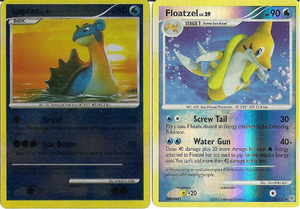Counterfeit card

Counterfeit cards, often referred to as fake cards, are cards created by someone other than the original creators of a particular trading card game in order to sell to unsuspecting consumers. They are distinct from fan-made cards, which are custom cards created by fans without the intent to pass them off as legitimate and sell them for a profit.
Since the release of the Pokémon Trading Card Game, mass-produced fakes have been made and sold in places like farmers' markets, dollar stores, and on the Internet.
History
Counterfeit cards began appearing shortly after the Pokémon TCG grew in popularity in Japan. Counterfeit Pokémon cards are generally made with cheaper, lesser quality materials which make them inferior to legitimate Pokémon cards.
In the early days of the Pokémon Trading Card Game, when the cards were gaining popularity in Western countries, counterfeit Pokémon cards frequently appeared in hopes of fooling unsuspecting buyers unfamiliar with the Pokémon franchise, as well as buyers who were unconcerned with the legitimacy of the cards, as Pokémon merchandise was in high demand and stores would often be out-of-stock. Early counterfeit cards, made by companies such as Q-boy, were printed on cheaper card stock and usually missing copyright information. Due to the cheap reproduction technologies used, counterfeit cards usually have lower-quality artwork, with print colors varying from the originals.
In the late 1990s, police forces seized thousands of fake Pokémon cards, including over 500,000 from a warehouse in Hackensack, New Jersey.[1]
Recent counterfeits are often more sophisticated, however, they still have many flaws. Modern counterfeits often contain critical spelling, grammatical, visual or factual errors. Common errors include the absence of the accented "é", wrong or mis-sized energy symbols, misnamed Pokémon (such as "Farren" for Flareon or "Lation" for Latios), or the illustrator's name will be misspelled (e.g. Mitsuhiro Arita's spelled "Mistuhiro Arita"). Often, counterfeit cards will be misprinted, making them a humorous farce of the original; like a Psychic-type Rattata card with an attack that does 1000 damage, or a Magneton with 800 HP.
Counterfeit detection
Over time, many counterfeit Pokémon cards have become increasingly difficult to distinguish from legitimate cards. Some are similar enough that the only noticeable difference may be a slightly different font on the front of the card. However, there are tests that can be used to consistently determine a card's legitimacy.
The border test
The back border of a real card should be a deep, dark blue color. Although this color can vary slightly between cards, if a card has a pale blue background, it's definitely a fake.
The rip test
Real cards generally have 3-4 layers: the front layer, the back layer, a black middle layer, and, depending on the card, a holofoil layer. Fake cards, however, are more cheaply produced, and lack the middle black layer. Thus, if a card is ripped and there is no black, it is a counterfeit. Although it is known as the rip test, the black layer in a real card can be seen without ripping it by looking closely at its side.
The light test
It is a widespread belief that, if you hold a card against a light, it will shine through the card if it is fake and will be completely opaque if it is legitimate. However, this is a very unreliable method of determining a card's legitimacy, as whether the light shines through the card can depend on factors such as the intensity of the light and how close to the light the card is held. It is recommended that you use one of the aforementioned methods instead.
References
- ↑ Hintze, Hal. "Fake 'n' Bake." PoJo's Unofficial Pokémon News & Price Guide Monthly Dec. 1999: 120-21.
External links
- Anatomy of a Fake Pokémon Card Article at the PokéGym discussing how to spot a counterfeit Pokémon TCG card.
See also

|
This article is part of Project TCG, a Bulbapedia project that aims to report on every aspect of the Pokémon Trading Card Game. |
